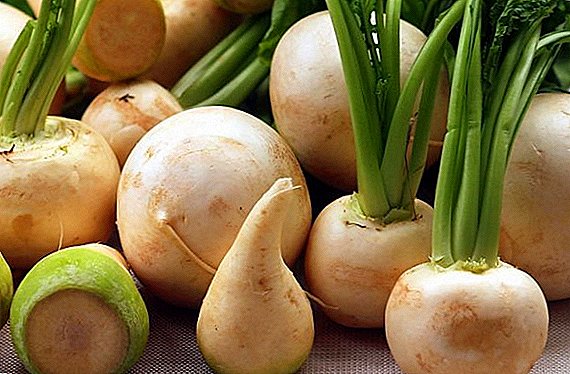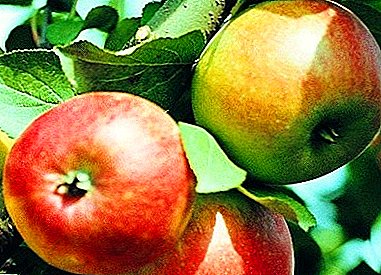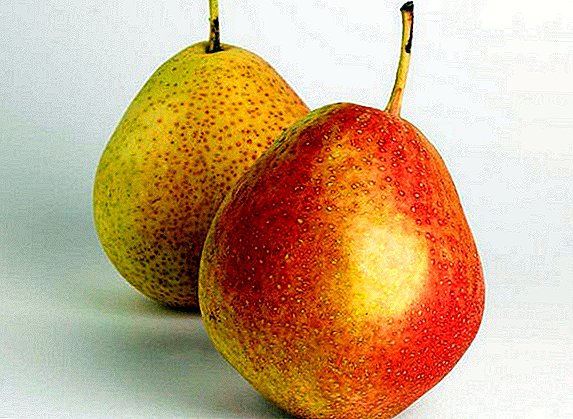 The anatomical structure of rabbits is very similar to the structure of the body of other mammals, but still has its own characteristics.
The anatomical structure of rabbits is very similar to the structure of the body of other mammals, but still has its own characteristics.
Today we look at the structure of the skeleton, the internal organs and the main body systems of these animals.
Skeleton
In the skeleton of a rabbit there are 112 bones, it is necessary for the protection of internal organs and the implementation of movements. The weight of the skeleton in adults is about 10% of the total body weight, in young animals - 15%. The bones that make up the skeleton are connected by cartilage, tendons and muscles. The skeleton of a rabbit consists of peripheral and axial.
Did you know? In the wild, rabbits live very little - only 1 year, while domestic animals sometimes live to 12 years.
Peripheral
This part of the skeleton includes the bones of the limbs:
- Thoracic, consisting of the humerus, shoulder blades, hands, forearm. The hand has a certain number of bones: metacarpal - 5, carpal - 9 fingers.
- The pelvic, having a pelvis, ileum, sciatic and pubic bones, lower legs, thighs, feet, 4 fingers and 3 phalanges.

Axial
This part of the skeleton consists of the main bones - the skull and ridge.
Familiarize with the meat, down, ornamental breeds of rabbits.The structure of the axial skeleton is represented by:
- Skull, consisting of the brain and facial. The skull is characterized by the presence of movable bones that are interconnected by defined sutures. In the brain region there are 7 bones, represented by the parietal, occipital, temporal and other. The facial region has maxillary, nasal, lacrimal, zygomatic, palatal bones. The shape of the skull is elongated, the external similarity with the skull of other mammals can be traced. The main part of the skull is occupied by organs that carry out breathing and eating.
- The body is characterized by the presence of the spinal column, the sternum bone, and the ribs. The ridge is divided into 5 sections or divisions. The backbone of the rabbit is quite flexible, due to the presence of menisci connecting the vertebrae.
 The bodies of the vertebrae work in compression, while the ligaments and muscles connecting the vertebrae to each other, in tension.
The bodies of the vertebrae work in compression, while the ligaments and muscles connecting the vertebrae to each other, in tension.The main sections of the spine are:
- cervical, consisting of 7 vertebrae;
- Thoracic, consisting of 13 vertebrae, which connect with the help of the ribs and form the chest, which contains the heart and lungs;
- lumbar with 7 vertebrae;
- sacral with 4 vertebrae;
- caudal with 15 vertebrae.
Important! Rabbit meat breeds have vertebrae wider than usual, which often helps breeders in choosing the right animal when buying.
Muscular system
The degree of development of the muscles in rabbits makes it possible to prematurely form the concept of the features of the appearance and taste of meat. 
The muscular system of rabbits is represented by:
- musculature of the body, which, in turn, consists of striated muscles, covering absolutely all the muscles of the body;
- muscles of the internal organs, which covers the smooth muscles covering the respiratory organs, organs of the digestive system, vascular walls.
Small rabbits have an underdeveloped muscular system, which takes up less than 20% of the total weight of the animal, and as they grow older, the muscles build up and reach 40%.
Find out what is remarkable for the water rabbit.
Nervous system
The nervous system of rabbits consists of:
- central, represented by the brain and spinal cord;
- peripheral, presented by nerves of skeletal muscles, vessels and skin.

The hemispheres of the brain of this animal are separated by a small groove, the brain has three sections, represented by the middle, posterior, oblong, each of which is necessary to perform separate functions. For example, thanks to the oblong section, the work of the respiratory organs and blood circulation processes takes place.
The spinal canal allows the spinal cord, the beginning of which is located in the brain, and the end to be located in the seventh cervical vertebra. The weight of the spinal cord is 3.5 g. The peripheral region consists of spinal, cranial nerves and nerve endings.
Learn about rabbit ear, eye, skin diseases.
The cardiovascular system
This system covers all processes in the body of a rabbit that deal with blood, that is, the blood-forming organs, the lymphatic system, veins, arteries and capillaries. Each element is required to perform certain functions.
The body of the rabbit contains an average of 250-300 ml of blood. In winter, the animal is characterized by low body temperature, which is +37 ° C, in summer it is +41 ° C. 
The rabbit heart has 4 chambers consisting of two ventricles and two atria. Its weight is 7 g, the position is the pericardial serous cavity. Normal pulse for an animal - within 140 beats per minute.
Important! If the rabbit's body temperature rises by 3 degrees in the summer and reaches +44 ° C, then it will die.
Digestive system
This system in the body allows the processing of food consumed by the rabbit. The full cycle - from ingesting to processing food in the gastrointestinal tract - is three days.
Teeth
Being born, the rabbit already has 16 teeth, in the process of growth, at week 3, there is a change of milk teeth to the root ones. Adults have 28 teeth, their growth occurs stably throughout their lives. 
The jaws consist of large incisors, designed to crush solid food, and indigenous, which are necessary for grinding other food. Food that has been ground by the teeth is transported to the pharynx, the next stage is transportation to the esophagus and stomach.
Stomach
The rabbit is a hollow organ of about 200 cu. see which is capable of producing gastric juice. Gastric enzymes in a rabbit are highly active when compared with other animals. Fiber, which ears are consumed, the stomach does not digest, it is sent to the intestine.
Find out what to do if a rabbit sneezes, if the rabbits have a bloated stomach, if the rabbit has diarrhea, or constipation, if the rabbit has hair, if the rabbit has teary eyes.
Intestines
Residues of food that the stomach has not managed to get into the intestine, carrying out the final processes of digestion.
The body is represented by:
- The small intestine, which is engaged in the breakdown of substances, including amino acids, which directly enter the blood.
- Large intestine, which is engaged in fermentation processes. Food that has not been split and digested, comes out under the guise of feces, its amount - 0.2 g per day. In the daytime, feces are characterized by a solid form, at night - soft. The feces that are excreted at night, the animals eat, due to which they receive the necessary proteins, vitamins K and B.

Respiratory system
The respiratory organs in a rabbit are represented by the nose, throat, trachea and lungs, which allow the body to provide oxygen. Inhaling the air, in the nose it is heated, moistened, cleared of impurities. Then begins its advancement into the pharynx, trachea and lungs.
Learn how to choose a rabbit when buying, how to correctly determine the age of the rabbit, how many rabbits live on average.
Rabbit breathing is increased compared with other mammals. 280 breaths per minute are considered normal. Ushastik have accelerated gas exchange processes: consuming about 480 cubic meters. cm of oxygen, they emit 450 cu. cm carbon dioxide. 
Sense organs
Individuals have such senses:
- Smellingwhich is possible thanks to prescription cells located in the depths of the nose. Cells have 11 hairs that respond to a variety of flavors. Thanks to the sense of smell, individuals choose a mate for mating, and the female can distinguish her cubs from strangers by smell.
- Tastewhich catch special nipples covering the tongue.
- By touchThe functioning of which occurs with the participation of sensitive skin, located on the eyelids, lips, back and forehead. Thanks to this feeling, pets can orient themselves in space, perceive temperature drops and avoid overheating, respond to painful irritations. Thanks to the antennae, animals can move at night when the cage is completely dark. The hairs located above the eyelids allow the rabbits to navigate and feel the obstacles.
- By sightwhich is provided by the eyes, consisting of an eyeball in the shape of a sphere, connected to the brain. Rabbits can distinguish colors, and a feature of vision is hyperopia and the possibility of orientation in the dark.
- Hearing, due to the big ears, which allow rabbits to identify and recognize sounds well.

Genitourinary system
This system in the body of rabbits consists of genital and urinary organs. Urinary organs are necessary for the elimination of decay products from the body. The amount of urine excreted directly depends on the age and nutrition of animals. Per day one individual can produce no more than 400 ml of urine. The urinary canal is located very close to the sexual apparatus.
Did you know? Communication between animals is possible due to high-frequency sounds. To capture some of them, individuals can rotate the auricles in different directions.
Mammals have two oval buds, which lie in the lumbar region and are necessary for the processes of decomposition of proteins, mineral salts and other substances.
The formation of urine occurs continuously, from the kidneys, it enters the ureters, after which it is excreted. The normal color of the excreted fluid is yellow-straw color, yellow or amber urine is considered a sign of disease.
Sex organs
There are obvious sex differences between males and females. Males have 2 testes, vas deferens, accessory glands, penis.  Rabbit sex organs
Rabbit sex organs
The reproductive system of females is represented by the uterus, ovaries, oviduct, vagina, and genital opening. The maturation of the eggs occurs in the ovaries, in the process of ovulation, they are transported into the oviduct.
Learn how to determine the sex of a rabbit, how to emasculate rabbits at home, when you can allow the rabbit to be mated, how long it lasts, and how to determine the sugaryness of the rabbit, how to feed the nursing rabbit after the appetite.
The uterus has a two-horned form, so that the female can bear 2 litters from two different males at once, ovulation processes begin 12 hours after mating.  Sex organs of adult rabbit
Sex organs of adult rabbit
Endocrine glands
Rabbit endocrine glands are made up of the thyroid, pituitary, pineal, pancreatic, adrenal glands, testes and ovaries. The developed hormones immediately enter the bloodstream, without the possibility of leaving the body.
The adrenal glands perform the function of regulating water and fat metabolism, thanks to the pituitary gland, the production of basic hormones. If there are any deviations in the number of glands and their work, this often leads to problems of growth and development of individuals.
Learn how to score a rabbit at home, how to make a rabbit skin.
Thus, having studied in detail the anatomy of a rabbit, farm owners can determine in time the presence of any abnormalities in these animals in order to immediately respond and begin treatment.












